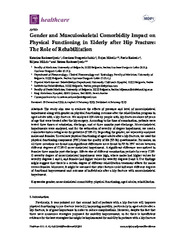Приказ основних података о документу
Gender and Musculoskeletal Comorbidity Impact on Physical Functioning in Elderly after Hip Fracture: The Role of Rehabilitation
| dc.creator | Radosavljević, Katarina | |
| dc.creator | Dragović-Lukić, Gordana | |
| dc.creator | Nikolić, Dejan | |
| dc.creator | Radović, Pavle | |
| dc.creator | Miličić, Biljana | |
| dc.creator | Radosavljević, Natasa | |
| dc.date.accessioned | 2020-07-02T13:29:42Z | |
| dc.date.available | 2020-07-02T13:29:42Z | |
| dc.date.issued | 2020 | |
| dc.identifier.issn | 2227-9032 | |
| dc.identifier.uri | https://smile.stomf.bg.ac.rs/handle/123456789/2511 | |
| dc.description.abstract | The study aim was to evaluate the effects of presence and level of musculoskeletal impairment along with gender on physical functioning outcome after the rehabilitation program in aged adults with a hip fracture. We analyzed 203 elderly people with hip fractures above 65 years of age that were treated after the hip surgery. According to the time of examination, patients were tested three times: at admission, discharge, and at three months post-discharge. Musculoskeletal impairments were analyzed, and for the estimation of severity of degree impairment, we used a cumulative index rating scale for geriatrics (CIRS-G). Regarding the gender, we separately analyzed males and females. To evaluate physical functioning of aged adults after a hip fracture, we used the physical functioning component (PFC) from the quality of life (SF-36) questionnaire. For males, on all three occasions we found non-significant differences were found in SF-36 PFC values between different degrees of CIRS-G musculoskeletal impairment. A significant difference was noticed in females three months post-discharge. Effects size of different examination periods for every CIRS-G severity degree of musculoskeletal impairment were high, where males had higher values for severity degrees 1 and 2, and females had higher values for severity degrees 0 and 3. Our findings might suggest that there is a certain degree of different rehabilitation treatment effects for males versus females. Moreover, it might be assumed that other factors could influence different degrees of functional improvement and outcome of individuals after a hip fracture with musculoskeletal impairment. | en |
| dc.publisher | Mdpi, Basel | |
| dc.rights | openAccess | |
| dc.source | Healthcare | |
| dc.subject | gender | en |
| dc.subject | musculoskeletal comorbidity | en |
| dc.subject | physical functioning | en |
| dc.subject | aged adults | en |
| dc.subject | rehabilitation | en |
| dc.title | Gender and Musculoskeletal Comorbidity Impact on Physical Functioning in Elderly after Hip Fracture: The Role of Rehabilitation | en |
| dc.type | article | |
| dc.rights.license | ARR | |
| dcterms.abstract | Николић, Дејан; Драговић-Лукић, Гордана; Радовић, Павле; Радосављевић, Натаса; Миличић, Биљана; Радосављевић, Катарина; | |
| dc.citation.volume | 8 | |
| dc.citation.issue | 1 | |
| dc.citation.other | 8(1): - | |
| dc.citation.rank | M22~ | |
| dc.identifier.wos | 000523720400007 | |
| dc.identifier.doi | 10.3390/healthcare8010031 | |
| dc.identifier.pmid | 32033047 | |
| dc.identifier.fulltext | https://smile.stomf.bg.ac.rs/bitstream/id/3445/2506.pdf | |
| dc.type.version | publishedVersion |


